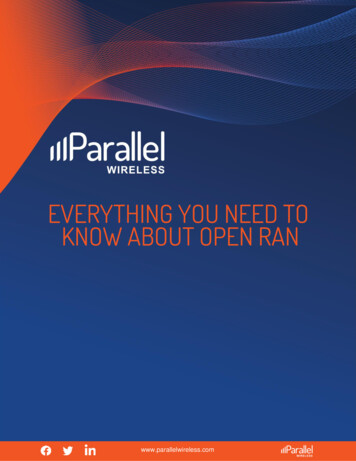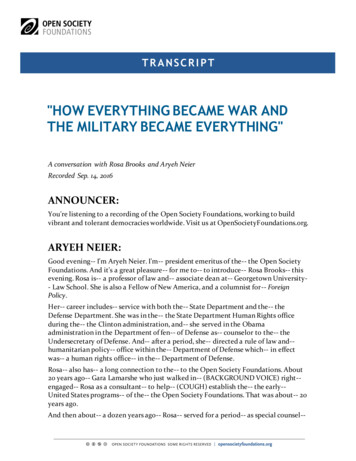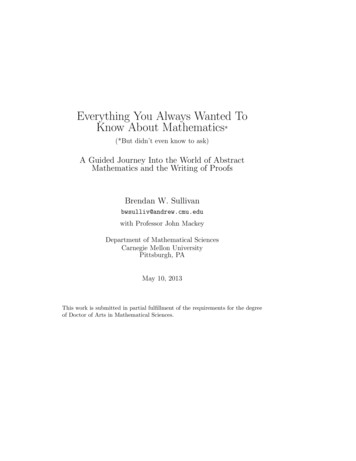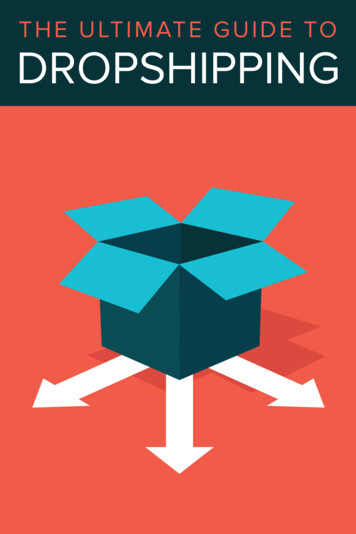
Transcription
EVERYTHING YOU NEED TOKNOW ABOUT OPEN RANwww.parallelwireless.com
Table of ContentsIntroduction .6Open RAN, OpenRAN or ORAN? .6Open RAN Summary .7Open RAN Groups.7Telecom Infra Project (TIP) . 7O-RAN Alliance . 8TIP vs O-RAN Alliance? . 10The O-RAN Alliance . 10TIP. 10Other Key Open RAN Groups . 10C-RAN, Virtual RAN (vRAN) and OpenRAN . 12C-RAN. 13vRAN. 13Virtualized RAN (VRAN) versus OpenRAN . 14Open RAN . 14O-RAN Groups Summary . 15The Need for Open Interfaces . 153GPP Interfaces . 15X2 Interface . 16The Interface Options for MNOs to Create an Open RAN Network . 17Open Interfaces Summary . 18Open RAN Components and RAN Functional Splits . 18RU, CU and DU . 18 2020 Parallel Wireless. All rights reserved.www.parallelwireless.com2
Components and Functional Splits Summary . 20Deep Dive into RU, DU, CU . 20RAN Functional Split 6 . 22RAN Functional Split 7 . 22RAN Functional Split 8 . 23RU, DU, CU Summary. 24RAN Automation with CI/CD . 25Virtualization: VNFs and Containers . 25CI/CD Overview . 26DevOps . 26Real Life Examples of CD/CI Deployments in Telecom . 28Internet Para Todos (IpT) CI/CD . 29TIP CI/CD. 29CI/CD Summary . 29Role of RAN Intelligent Controller (RIC) . 30O-RAN Alliance Groups Working on RIC . 31Working Group 1 . 32Near Real-Time RAN Intelligent Controller (Near-RT RIC). 32Non-Real-Time RAN Intelligent Controller (Non-RT RIC) . 33RIC Overview . 34Multi-RAT CU Protocol Stack Function. 34The Near-RT RIC . 34Bringing It All Together: . 35RIC Implementations in Real Life: Nokia, Parallel Wireless . 35RIC Platform Summary . 39Integration of Open RAN and Beyond . 40 2020 Parallel Wireless. All rights reserved.www.parallelwireless.com3
Challenges of Open RAN Integration . 40Integration Opportunities . 41Open RAN Ecosystem Integration . 42System Integration of the Open RAN Software . 42Implementation Stage . 43Maintenance Stage . 44Operator Tasks in Integration . 44Role of Managed Service Providers in Integration . 47Role of Hardware and Software Vendors in Integration . 47Role of Integrators . 48Open RAN Integration Real Life Examples . 48Model 1 (MNO Integrates Themselves) . 48Model 2 (A Hardware Vendor Integrates) . 48Model 3 (Using a System Integrator) . 49Open RAN Timeline . 49Industry Timeline. 492016 . 502017 . 512018 . 512019 . 522020 . 52Open RAN and Beyond Summary . 53Global Open RAN Adoption . 55Emerging and Developed Economies . 55In Emerging Economies . 55In Developed Economies . 56 2020 Parallel Wireless. All rights reserved.www.parallelwireless.com4
Urban Versus Rural . 56Europe . 56Africa . 57Latin America . 58APAC . 59U.S. . 59Analyst Predictions . 60About Parallel Wireless. 62 2020 Parallel Wireless. All rights reserved.www.parallelwireless.com5
Everything You Need toKnow About Open RANIntroduction2020 is the year of Open RAN. Each week seems to bring some new announcement about thetechnology. While there is a lot of information, there is also confusion, incomplete stories, halftruths and even outright misinformation. In this paper, our goal is to simplify the world of OpenRAN for readers.Before we begin, it is important to note that Open RAN started as a movement that applies to allgenerations (or ALL Gs) of mobile technology. That is to say, Open RAN applies to 2G, 3G, 4G,5G and all future Gs.Open RAN, OpenRAN or ORAN?When people talk about Open RAN, you hear “Open” and “RAN,” but when they write about it, youmay see it in a variety of ways. You may also often see different hashtags used on social media,such as #oran and #OpenRAN. This can be very confusing when it comesto understanding which terms to use and when.“Open RAN” is the movement in wireless telecommunications to disaggregate hardware andsoftware and to create open interfaces between them.“OpenRAN” on the other hand could mean two different things. It could either refer to one of thetwo groups within the Telecom Infra Project (the OpenRAN project group, which is an initiativeto define and build 2G, 3G, and 4G RAN solutions based on general-purpose, vendorneutral hardware and software-defined technology, or the OpenRAN 5G NR project group whichfocuses on 5G NR). The other time you will typically see OpenRAN as one word is when it is usedas a hashtag on social media sites like Twitter, LinkedIn, or Facebook – for example, #OpenRAN.Source: Telecom Infra Project 2020 Parallel Wireless. All rights reserved.www.parallelwireless.com6
Next up are “O-RAN” and “ORAN.” O-RAN with the hyphen refers to the O-RAN Alliance,which publishes new RAN specifications, releases open software for the RAN, and supports itsmembers in integration and testing of their implementations. “ORAN” can also be used to refer tothe Open RAN movement; however, O-RAN with the hyphen always refers to the O-RAN Alliance.#oRAN or #ORAN are also used as hashtags on social networks to refer to either the O-RANAlliance or to the Open RAN movement.Open RAN SummaryOpen RAN overall movementOpenRAN in reference to TIP Groups or used as a hashtagO-RAN and oRAN in reference to the O-RAN alliance or used as a hashtagSource: Parallel WirelessOpen RAN GroupsThere are a variety of Open RAN groups and advocacy organizations focused on Open RAN, andit can be a challenge to understand the role each plays in the telecoms industry. Here, we will takea closer look at the key Open RAN industry groups, as well as other important initiatives aroundOpen RAN.Telecom Infra Project (TIP)The first of the two industry groups who are leading the Open RAN movement is Telecom InfraProject, or TIP. TIP was formed by Facebook in 2016 as an engineering-focused, collaborativemethodology for building and deploying global telecom network infrastructure, with the goal ofenabling global access for all. TIP is jointly steered by its group of founding tech and telecomcompanies, which forms its board of directors. It is currently chaired by Vodafone’s Head ofNetwork Strategy and Architecture, Yago Tenorio. Member companies host technology incubatorlabs and accelerators, and TIP hosts an annual infrastructure conference known as TIP Summit. 2020 Parallel Wireless. All rights reserved.www.parallelwireless.com7
Source: Parallel WirelessWith more than 500 participating member organizations, including operators, vendors,developers, integrators, startups and other entities that participate in various TIP project groups,TIP adopts transparency of process and collaboration in the development of new technologies. Allprojects are member–driven and employ current case studies to evolve telecom equipment andsoftware into more flexible, agile, and interoperable forms.As a company, Parallel Wireless is focused on the OpenRAN and OpenRAN 5G NR groups asyou may have learned in our educational Open RAN videos. The OpenRAN project group is aninitiative to define and build 2G, 3G and 4G RAN solutions based on general-purpose, vendorneutral hardware and software-defined technology. The OpenRAN 5G NR project group, as thename suggests, focuses on 5G NR, or New Radio. And why is Parallel Wireless, along with agrowing number of the telecoms industry, so focused on Open RAN? Because the generalconsensus is that RAN is 60% of CAPEX and OPEX. Open RAN helps significantly reduce RANcosts, and reducing RAN costs can significantly help mobile network operators cut downtheir CAPEX.O-RAN AllianceThe second group leading the Open RAN movement is the O-RAN Alliance, which was foundedin February 2018 with the intention of promoting open and intelligent RAN. It was formed by amerger of two different organizations, namely the C-RAN Alliance and the XRAN Forum. The CRAN Alliance consisted of China Mobile and a lot of other Chinese vendors. On the other hand,the XRAN Forum consisted of US, European, Japanese and South Korean vendors andoperators. AT&T, China Mobile, Deutsche Telekom, NTT Docomo and Orange were the initialfounding operators. Since then many more operators, vendors, integrators, etc. have joined. 2020 Parallel Wireless. All rights reserved.www.parallelwireless.com8
Source: Parallel WirelessDue to an increase in the amount of traffic resulting from better devices, newer applications, fasterconnections and even generous data plans, a complete paradigm shift is required for mobilenetworks. While 3GPP does an excellent job of defining these new flexible standards separatingthe user and control planes and keeping the different implementation options open, organizationslike the O-RAN Alliance have an important role in bringing the industry together to create a moresoftware-based, virtualized, flexible, intelligent and energy–efficient network. These goals can beachieved by evolving RAN to a higher level of openness and intelligence, and the O-RAN Alliancedoes just that. They specify reference designs consisting of virtualized network elements usingopen and standardized interfaces, and they call for more intelligence in thenetwork through information collection for these virtualized network elements. ArtificialIntelligence (AI) and Machine Learning (ML) can then be applied on this collected information.The O-RAN Alliance lays out their vision on their website. As discussed earlier, thereare two high–level goals:1. The first is openness, which will help bring service agility and cloud–scale economics to enablesmaller vendors and operators to introduce their own services or customize the network to suittheir own unique needs. As we have discussed in our videos, open interfaces enable multivendor deployments, enabling a more competitive and vibrant supplier ecosystem. Finally, opensource software and hardware reference designs enable faster, more democratic andpermission-less innovation.2. The second goal is to automate these increasingly complexnetworks, thereby simplifying operation and maintenance, which in turn will reduce OPEX. Thiswill be possible by embedding intelligence using emerging deep learning techniques in everylayer, at both the component and network levels of the RAN architecture. In combinationwith the standardized southbound interfaces, AI-optimized closed-loop automation is achievableand is expected to enable a new era for network operations. As in case of TIP groups, the ORAN Alliance have their own set of working groups. These nine working groups can be broadlydivided as follows: 2020 Parallel Wireless. All rights reserved.www.parallelwireless.com9
Work Group 1 Focuses on studying use cases and overall architecture.Work Group 2 Focus on optimization and automation of the RAN Radio ResourceManagement, or RRM, using the RAN Intelligent Controller, or RIC.Work Group 3Work Group 4Work Group 5Work Group 6Work Group 7 Focus on open interfaces for achieving interoperability between differentRAN hardware and software vendors. Focus on commoditization, virtualization and modularization of RANhardware and software.Work Group 8Work Group 9 Focuses on the new open transport network based on new architectures andend-user service requirements for fronthaul, midhaul and backhaul,collectively known as X–haul.TIP vs O-RAN Alliance?It may be confusing as to the role each of these organization plays in the industry. Here is a quickbreakdown between the two leading Open RAN organizations.The O-RAN Alliance develops, drives and enforces standards to ensure that equipment frommultiple vendors interoperate with each other. It creates standards where none are available – forexample, the fronthaul specifications. In addition, it creates profiles for interoperability testingwhere standards are available – for example, the X2 interface. Of course, there are many morethings the O-RAN Alliance does, as described earlier.TIP is more deployment and execution focused; they encourage Plugfests and live deploymentsin the field. TIP enables the Open RAN ecosystem, ensures different vendors’ software andhardware equipment works with each other, is responsible for productization of use cases, andfacilitates trials, field testing and deployment. The O-RAN Alliance is heavily focused on 5G and4G, whereas TIP is focused on solutions across All Gs –2G, 3G, 4G and 5G. It would also bereasonable to say that the Open RAN movement owes its popularity and success to the initialsteps that TIP took by bringing together a community of service providers, software and hardwarevendors, system integrators and other connectivity stakeholders to facilitate real-world trials anddeployments in different operators’ networks.Earlier this year, these two groups announced a liaison agreement to ensure their alignment indeveloping interoperable Open RAN solutions. Because TIP is agnostic about the specificationsit uses to create the solutions service providers are looking for, it has to work with variousstandards bodies to ensure smooth operation. But the liaison agreement with O-RANAlliance allows for the sharing of information, referencing specifications and conducting jointtesting and integration efforts. So, if you look at the TIP OpenRAN 5G NR Base Station Platformrequirements document, you see normative references to the O-RAN Alliance specifications.Within TIP, only companies that are members of both TIP and the O-RAN Alliance can participatein any discussions related to O-RAN specifications.Other Key Open RAN GroupsThe O-RAN Software Community is a collaboration between the O-RAN Alliance and LinuxFoundation, with a mission to support the creation of open-source software for the RAN. Thegoal of the O-RAN Software Community is to advance opening the Radio Access Network withfocus on the open interfaces, followed by implementations that leverage new capabilities enabledby O-RAN specifications. In December 2019, the O-RAN Software Community released its firstsoftware code called “Amber.” It covered initial functionality of the O-RAN unique Near Real-TimeRAN Intelligent Controller, the O1 interface and the protocol stack. 2020 Parallel Wireless. All rights reserved.www.parallelwireless.com10
Source: Parallel WirelessThe Small Cell Forum, or SCF, has created its own ecosystem of Open RAN with small cells inmind. Recently they have been focusing heavily on creating open interfaces. In 2020, theyexpanded the set of specifications they released the previous year, to enable small cells to beconstructed piece-by-piece using components from different vendors, in order to easily addressthe diverse mixture of 5G use cases. These open interfaces are called FAPI and nFAPI, whichstands for network FAPI. FAPI helps equipment vendors to mix PHY & MAC software fromdifferent suppliers via this open FAPI interface. So, FAPI are ‘internal’ interfaces. On the otherhand, nFAPI, or more specifically 5G-nFAPI, is a ‘network’ interface and is between a DistributedUnit (DU) and Radio Unit (RU) of a split RAN small cell network solution. This will help networkarchitects by allowing them to mix distributed and radio units from different vendors. In short, theSCF nFAPI is enabling the Open RAN ecosystem in its own way by allowing any CU/DU toconnect to any small cell radio unit or S-RUThe Open RAN Policy Coalition is a new OpenRAN group that was announced in 2020. TheOpen RAN Policy Coalition represents a group ofcompanies formed to promote policies that willadvance the adoption of open and interoperablesolutions in the RAN as a means to createinnovation, spur competition and expand thesupplychainforadvancedwirelesstechnologies, including 5G. Its main goals are to: Source: SCF open specifications for disaggregationof small cell components and networks Support global development of open andinteroperable wireless technologies;Signal government support for open andinteroperable solutions;Use government procurement to support vendordiversity;Fund research and development;Remove barriers to 5G deployment; andAvoid heavy-handed or prescriptive solutions 2020 Parallel Wireless. All rights reserved.www.parallelwireless.com11
C-RAN, Virtual RAN (vRAN) and OpenRANThe entire telecom industry is going through a change that can be only compared to the changethat data centers went through in the 2000s, both driven by Moore’s Law.Source: Parallel WirelessThis allows to move from costly, proprietary solutions to COTS-based and open, software-basedones, and to create a broader vendor supply chain. How does this concept apply to the RAN?Most of the CAPEX required to build a wireless network is related to the RAN segment, reachingas high as 80% of the total network cost. Any reduction in the RAN equipment cost will significantlyhelp the bottom line of wireless operators as they struggle to cope with the challenges of everincreasing mobile traffic and declining revenues.Though the RAN interfaces are “supposed” to be open as they are 3GPP-standards based, intraditional RAN deployments, the software and interfaces remain either proprietary or “closed” bythe individual vendor and are often tied to the underlying hardware by the SAME vendor. Meaning,operators cannot put vendor B’s software on a BBU from vendor A or connect a radio from vendorA to a vBBU hardware and software from vendor B. Any software upgrades are tied into theinstalled base, and if an operator wants to do a vendor A swap, they need to rip out all of it: fromthe vendor A radio to the vendor A BBU hosting the vendor A software – they cannot replace justone component in the legacy RAN deployment. This creates a vendor lock-in.Vodafone, the leading innovator in Open RAN, recently noted that “the global supply of telecomnetwork equipment has become concentrated in a small handful of companies over the past fewyears. More choice of suppliers will safeguard the delivery of services to all mobile customers,increase flexibility and innovation and, crucially, can help address some of the cost challengesthat are holding back the delivery of internet services to rural communities and remote placesacross the world.”Vodafone added that the move will improve “supply chain resilience,” introducing “a wave of new2G, 3G, 4G and 5G technology vendors, in addition to the existing market leaders.”It will be easier and cheaper to keep the radio from vendor A on the tower, installed, so no onehas to climb up and replace it, and then keep the COTS-based BBU at the bottom of tower, andthen just simply upgrade the software from vendor A to software from vendor B remotely without 2020 Parallel Wireless. All rights reserved.www.parallelwireless.com12
going to a site. This is exactly what Open RAN enables: the mixing and matching of software andhardware (radios and COTS servers) without the need to rip and replace. This, however, is not tobe confused with C-RAN or vRAN. Let us explain why.C-RANAbout 10 years ago, virtualization of the RAN functions started with the C-RAN (cloud RAN orcentralized RAN) initiative from IBM, Intel and China Mobile. C-RAN resulted in a deploymentmodel where a baseband unit that was doing digital processing could be located in a data centerand not on the site itself, under the radio where the processing was happening in legacy RANs.Instead, radios were connected to the baseband in the data center unit via a dedicated highbandwidth connection. This made C-RAN deployments only applicable to areas where there wasaccess to fiber.Source: OrangeC-RAN required a new fronthaul interface, and various industry standards such as the CommonPublic Radio Interface (CPRI) and the Next Generation Fronthaul Interface (NGFI) evolved toenable these new interfaces between the radios and baseband. C-RAN wasn’t necessarily open,but it did begin the movement toward disaggregating the RAN. However, the use cases, becauseof pooling all digital processing in a centralized location, were limited to high density urban. Andit still did not solve issue of vendor lock-in.vRANNext came Virtual RAN, or, vRAN. Does Virtual RAN equal Open RAN? Not exactly. With vRAN,the proprietary radio hardware remains as it is, but the BBU gets replaced by a COTS serverrather than being proprietary BBU hardware. The software that runs on the BBU is virtualized torun on any COTS server. But the proprietary interfaces between radios and COTS-based BBUremain as they are. 2020 Parallel Wireless. All rights reserved.www.parallelwireless.com13
Virtualized RAN (VRAN) versus OpenRANSource: Parallel WirelessSo, though RAN functions are virtualized on a COTS server, the interface between the BBU andRRU / RRH is not an open interface, so any vendor’s software cannot work with the RRU / RRHunless the interfaces become open. To use the analogy from the way we described legacy RANearlier, vRAN consists of vendor A radio and vendor A software running on a COTS BBU. Anoperator cannot put vendor B software on the same COTS BBU unless the interface to the vendorA radio is open. So, vRAN can still create vendor lock-in.Open RANThe key with Open RAN is that the interface between the BBU and RRU / RRH is an openinterface, so, any vendor’s software can work on any open RRU / RRH. More open interfacesenable the use of one supplier's radios with another's processors – which is not possible with CRAN or vRAN.Open RAN is a movement to define and build 2G, 3G, 4G and 5G RAN solutions based on ageneral-purpose, vendor-neutral hardware and software-defined technology with open interfacesbetween all the components. Open RAN Is the disaggregation of hardware and software: the RRU/ RRH hardware becomes a GPP-based or COTS hardware that can be purchased from anyODM, OEM or RAN hardware vendor (Vendor A). The BBU is the same as in the case of vRAN:a COTS server a vendor’s (Vendor B) proprietary software with virtualized functions.Open RAN makes the RAN open within all aspects and components, with the interfaces andoperating software separating the RAN control plane from the user plane, building a modular basestation software stack that operates on commercial-off-the-shelf (COTS) hardware, with opennorth- and south-bound interfaces. This software-enabled Open RAN network architectureenables a “white box” RAN hardware – meaning that baseband units, radio units and remote radioheads can be assembled from any vendor and managed by Open RAN software to form a trulyinteroperable and open “best of breed” RAN. This way, the underlying hardware layer (radios fromvendor A and COTS servers) can stay on site when a mobile operator decides to do a swap; theonly thing that gets replaced is the software from vendor B to vendor C. 2020 Parallel Wireless. All rights reserved.www.parallelwireless.com14
rviceSP/MNO could replace the OpenRAN software as easily as they did the hardware. Existing OpenRANhardware continues to work with the new software from Vendor V2CoreTransport NetworkV2OpenRAN SoftwareOpenRAN Hardwarefrom any ODM/OEM/RAN VendorCBACBBCABCSource: Parallel WirelessSo, a mobile operator can virtualize and disaggregate their RAN, but unless the interfacesbetween the components are open, the RAN is not truly open.O-RAN Groups SummaryOpen RAN is about horizontal openness – with open interfaces enabling functions of the RAN toconnect with other functions, from a radio unit (RU) to a baseband (DU-CU), to the controller tothe NMS/orchestrator.When RAN is opened up horizontally, it could bring in a new range of low-cost radio players, andit gives mobile operators a choice to optimize deployment options for specific performancerequirements at much better cost.The Need for Open Interfacesquestion that often comes up in Open RAN discussions is this: why do we need the Open RANmovement if the networks use 3GPP-based interfaces, which are already open and standardized?Here is our take on this important and relevant question.3G
EVERYTHING










